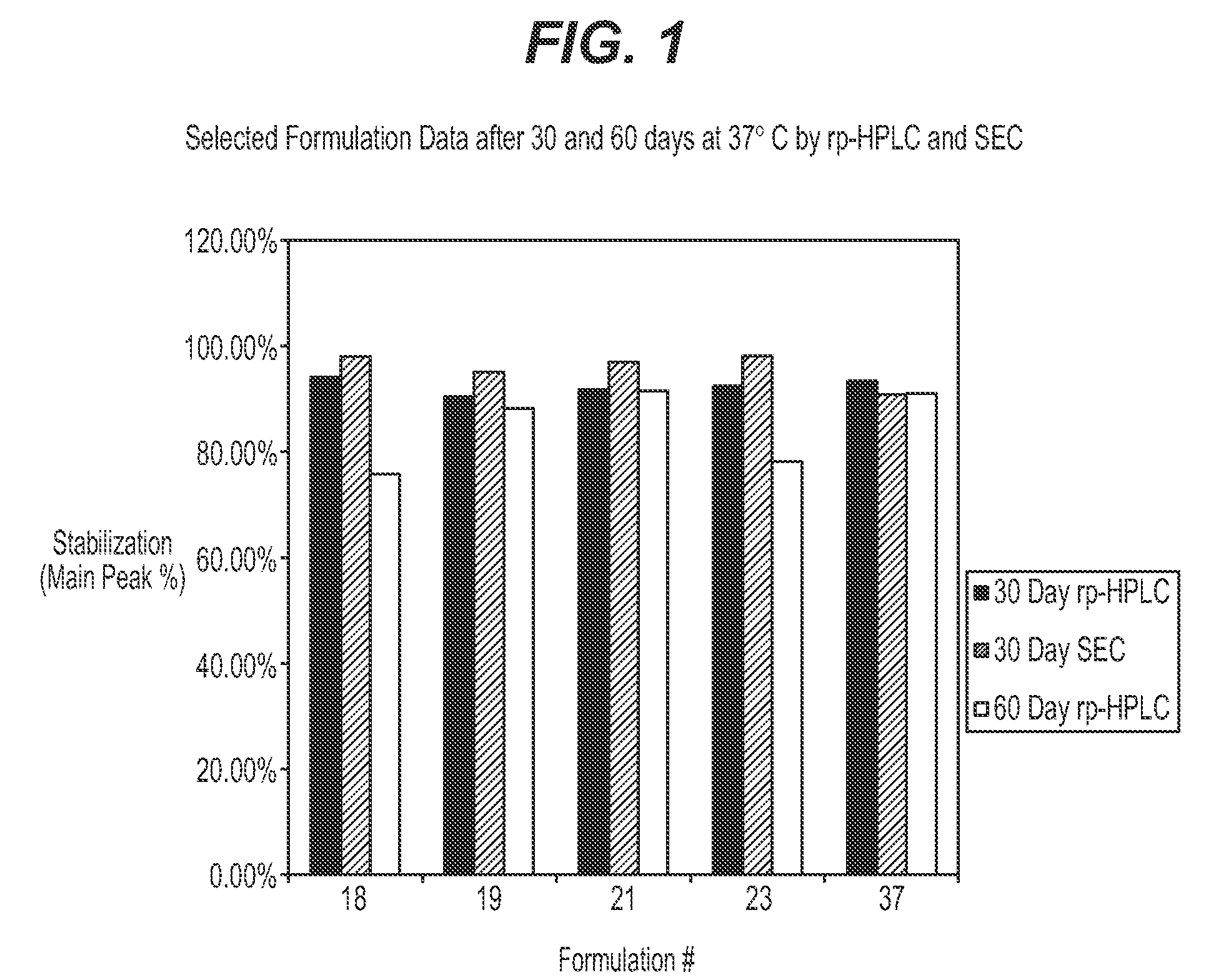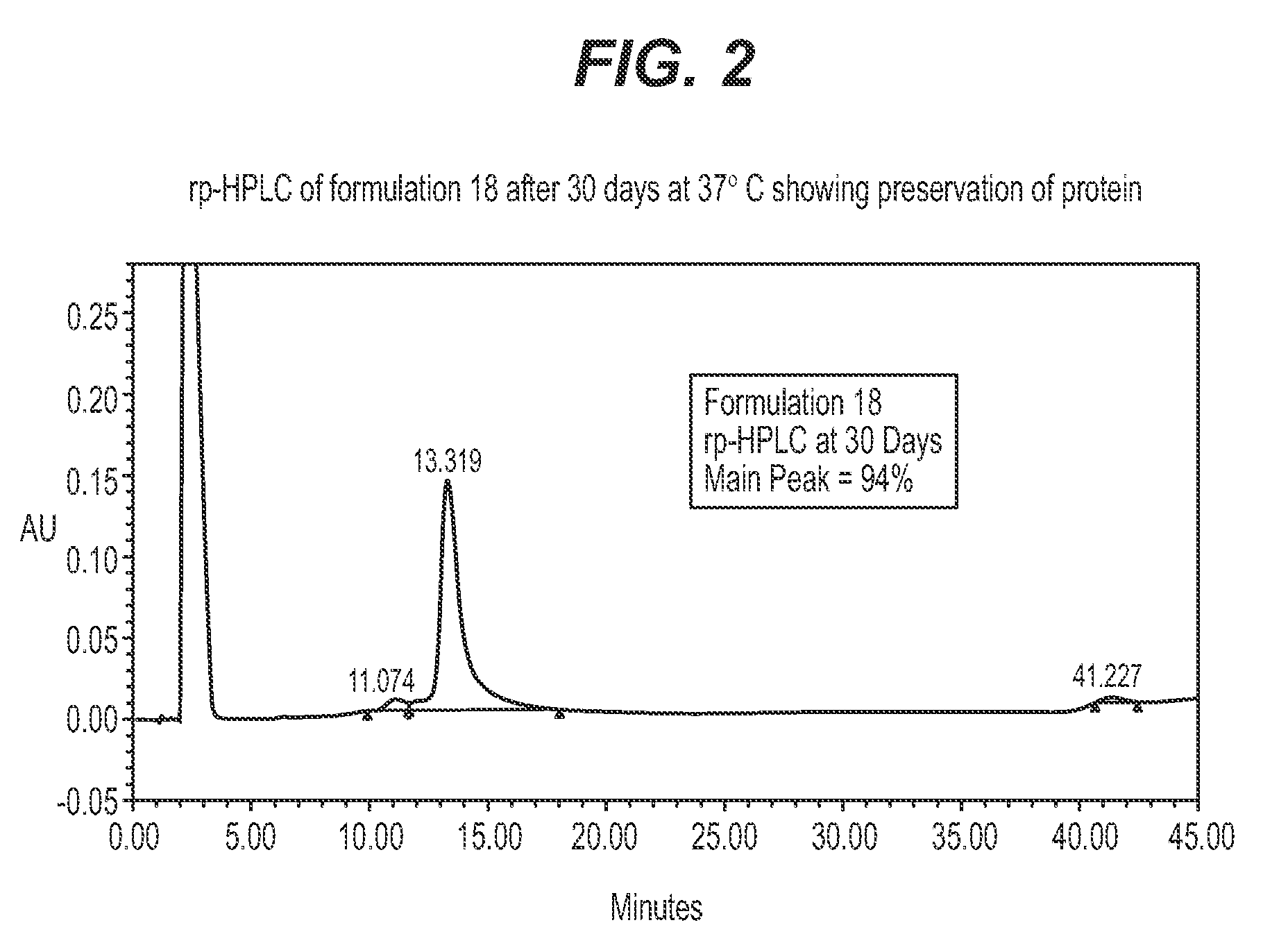Protein formulations for use at elevated temperatures
a technology of protein formulations and elevated temperatures, which is applied in the direction of osteogenic factors, peptide/protein ingredients, drug compositions, etc., can solve the problem that the use of formulations that are successful for other proteins is not necessarily predictabl
- Summary
- Abstract
- Description
- Claims
- Application Information
AI Technical Summary
Benefits of technology
Problems solved by technology
Method used
Image
Examples
example 1
[0042]Preparation of bulk trehalose 60% w / v solution: 165.78 g of trehalose dihydrate (MW 378.34) were carefully weighed and transferred to a 250 ml size, clean volumetric flask, to which 1 mmol HCl was added slowly to just below the mark. The mixture was mixed thoroughly by shaking and warming in warm water at 60° C. The volume was brought to 250 ml by adding more 1 mmol HCl and letting all of the crystals completely dissolve; the solution was then filtered through a 0.2 um filter. This solution was used for the preparation of the formulations. In an analogous manner a 50% w / v solution was made for formulations 32 & 36 using a 50% trehalose solution.
example 2
[0043]A non-limiting example of the preparation of a composition of the present invention is as follows (Formulation #19): 165.78 g of trehalose dihydrate (MW 378.34) were carefully weighed and transferred to a clean 250 ml volumetric flask, to which 1 mmol HCl was added slowly to just below the mark to produce a 60% w / v solution. The mixture was mixed thoroughly by shaking and warming in warm water at 60° C. The volume was brought to the mark by adding more 1 mmol HCl and ensuring that all of the trehalose crystals completely dissolved; the solution was then filtered through a 0.22 um filter. To 10 ml of the 60% trehalose solution, 51 mg of β-alanine and 10 mg of taurine were added. The mixture was swirled, to which 1000 ug (1 mg) of rhGDF-5 in solution was added. The protein concentration of the formulation was measured by UV light to ensure the desired concentration was achieved, and was adjusted by adding solvent or protein as needed.
example 3
[0044]In a preferred embodiment, a formulation of the present invention is prepared as follows (Formulation #21): 165.78 g of trehalose dihydrate (MW 378.34) were carefully weighed and transferred to a 250 ml size, clean volumetric flask, to which 1 mmol HCl was added slowly to just below the mark to produce a 60% w / v solution. The mixture was mixed thoroughly by shaking and warming in warm water at 60° C. The volume was brought to the mark by adding more 1 mmol HCl and ensuring that all of the trehalose crystals were completely dissolved; the solution was then filtered through a 0.22 um filter. To 10 ml of the 60% trehalose solution, 50 mg of β-alanine and 10 mg of triethylamine hydrochloride (TEA) were added. The mixture was swirled, to which 1000 ug (1 mg) of rhGDF-5 in solution was added. The protein concentration of the formulation was measured by UV light to ensure the desired concentration was achieved, and was adjusted by adding solvent or protein as needed.
PUM
 Login to View More
Login to View More Abstract
Description
Claims
Application Information
 Login to View More
Login to View More - R&D
- Intellectual Property
- Life Sciences
- Materials
- Tech Scout
- Unparalleled Data Quality
- Higher Quality Content
- 60% Fewer Hallucinations
Browse by: Latest US Patents, China's latest patents, Technical Efficacy Thesaurus, Application Domain, Technology Topic, Popular Technical Reports.
© 2025 PatSnap. All rights reserved.Legal|Privacy policy|Modern Slavery Act Transparency Statement|Sitemap|About US| Contact US: help@patsnap.com



